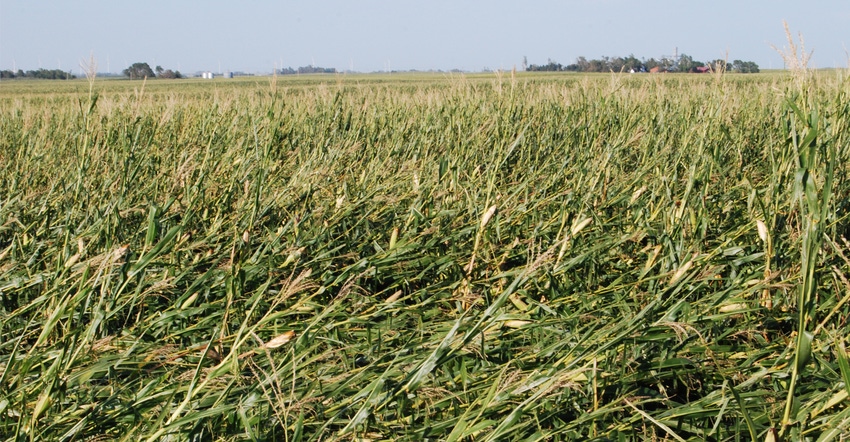September 3, 2020

Many fields have been ravaged by adverse weather this year in Iowa. On top of drought and hail, a devastating derecho windstorm steam-rolled a wide swath of Iowa starting in Sac County and progressing eastward along Highway 30. Along with the decision of how to handle this year’s damaged crop, farmers need to consider how to protect the soil in preparation for next year’s crop.
“Your plan should include cover crops,” advises Mark Licht, Iowa State University Extension cropping systems agronomist.
Use of cover crops after a crop is damaged by adverse weather can provide short-term protection of the soil while enhancing the long-term benefits of increased water infiltration, improved nutrient cycling and soil organism diversity. Using a cover crop to scavenge nitrogen will be especially important in areas of Iowa that experienced reduced yields due to drought conditions. Cover crops have shown a significant reduction in nitrogen loss from fields the year following a drought.
“Successful cover crop establishment will require managing the residue of the damaged corn crop to allow seed-to-soil contact when seeding the cover crop,” Licht says. “You also need to consider the likelihood of having sufficient soil moisture for cover crop establishment. The timing of when you seed the cover crop and getting a nice rain afterward is a key to getting a good cover crop stand.”
Moisture concerns
Cover crops need moisture to germinate, soil to root in and sunlight to grow. Timing and method of cover crop seeding will be critical this year for successful cover crop establishment, especially given the expanding drought. “Moisture is always a consideration for timing of seeding, and this will be no different this year for all parts of the state,” Licht says. “The decision on method of seeding to use [aerial, broadcast, broadcast or incorporate, or drill] will be more important than ever this year.”
Moisture is a concern for establishing the cover crop and for growing next year’s crop. It has been proven that good cover crop growth will increase infiltration rate, allowing more rainwater to be captured by the soil during rain events. “Terminating the cover crop earlier in the spring will conserve accumulated moisture if this dry weather pattern we are experiencing this fall continues through spring,” he adds.
Damaged crops
Best management practices for wind-damaged corn should be based on severity of the damage and how, or if, the crop will be harvested. Fields flattened by wind or with a high degree of green snap will have varying degrees of dense leaf cover. Evaluate fields prior to aerial seeding to determine how confident you are that you’ll be getting the seed in good contact with soil. In most cases, aerial application over these fields would be an acceptable method, but considerations must account for the planned method and timing of harvesting the damaged corn crop.
For fields that will be unharvested, and tillage will be used to size the crop residue, seeding a cover crop after the tillage operation will provide both soil cover and protection.
“Timing of planting the cover crop will dictate what cover crop species are best-suited to be planted,” Licht says. “If the tillage is done prior to mid-September, a mix of non-winter hardy species will provide fall protection and will not need to be terminated in the spring. Winter-hardy species are a great option anytime in the fall and will extend benefits of living roots and soil cover into the spring. Seeding dates vary across the state based on historical frost dates, but anytime seeding is past mid-September, a winter-hardy species is recommended.”
For fields of wind-damaged corn that are planned to be harvested for silage or baled, seeding the cover crop immediately after harvest will provide the best establishment window.
Harvesting downed corn pushes the limitations of both equipment and operator. “Seeding a cover crop too early could provide enough cover crop growth to further visually impede harvest,” Licht says. “Seeding after the crop is harvested with a drill to get good seed-to-soil contact will increase chances for successful establishment of the cover crop. Consider how the crop will be harvested along with severity of damage when deciding what cover crop species, method and timing of seeding will be used.”
Seeding options
Consider these factors when evaluating your seeding options:
Aerial or broadcast application. This should be timed 10 to 14 days before the canopy opens up. This is when soybeans have 10% to 20% of the leaves in the upper canopy turning yellow. For corn planned for grain harvest, this will be when kernels are at half milk line (mid-R5 stage of corn plant growth). Increased success with establishment will occur if moisture is received within 10 days of the aerial application. Use of aerial application on damaged corn needs to consider planned harvest method and current level of soil exposed.
Drilling or broadcast with incorporation. This method always provides the most consistent cover crop stand. A drawback to this method is the shortened time for fall growth of the cover crop, but using a winter-hardy cover crop like cereal rye or triticale are good options to consider. Physical disturbance of corn ears on the ground will promote germination of volunteer corn.
“Management of fields with downed corn will be a challenge,” Licht says. “But it does not eliminate the opportunity to seed cover crops yet this fall.”
Source: ISU, which is solely responsible for the information provided and is wholly owned by the source. Informa Business Media and all its subsidiaries are not responsible for any of the content contained in this information asset.
You May Also Like




